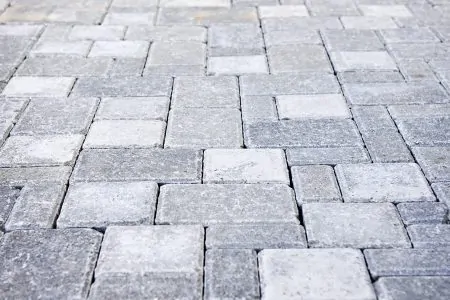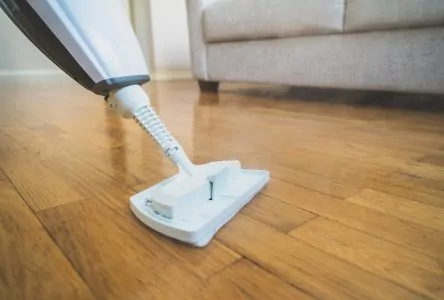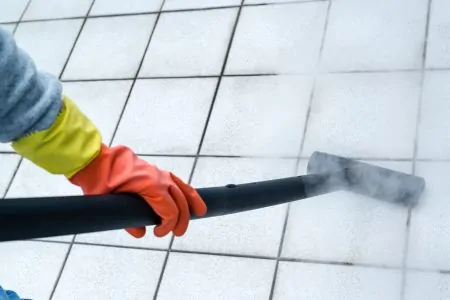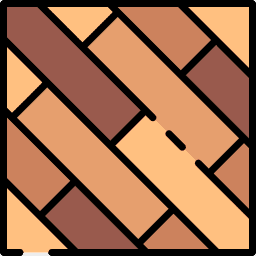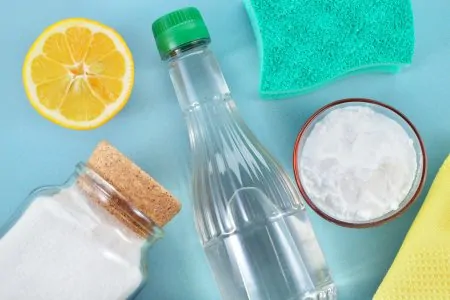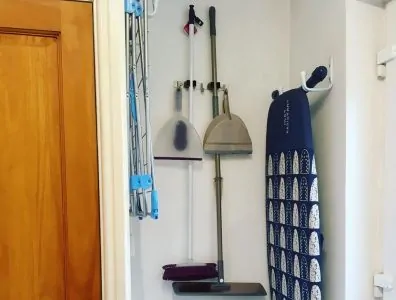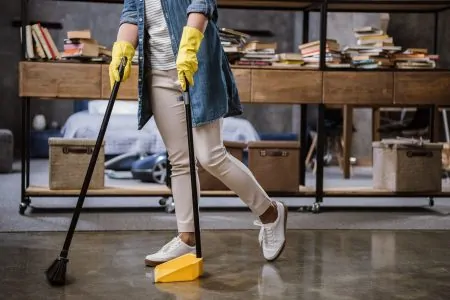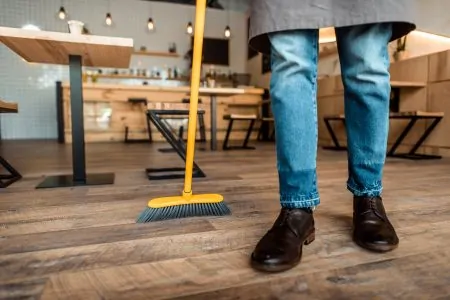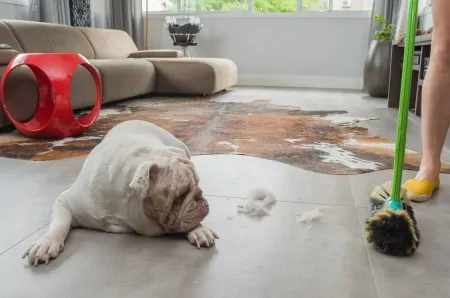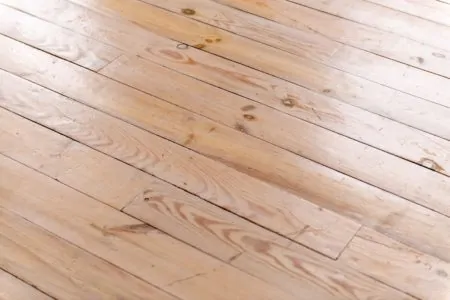Brick floors are easy to maintain, but are you cleaning them enough? This type of flooring can begin to look dirty quickly if not kept well.
Dirt and grit can act similar to sandpaper over time — damaging the seal and exposing the brick itself. This could cause your floor to degrade significantly.
You’ve come to the right place if you want to know how to clean brick floors the right way. We’ve put a step-by-step guide together, so you know exactly how to tackle this cleaning task.
Key Takeaways
- Vacuum or sweep brick floors daily to remove dirt and grit, focusing on the mortar between the bricks.
- Mop brick floors using a damp mop and a mild alkaline cleaner like borax, baking soda, or vinegar.
- Steam cleaners can effectively deep clean brick floors, removing spills, stains, and odors.
- Seal brick floors with a penetrating sealer or film-forming product to protect against stains and make maintenance easier.
Brick floors can bring a rustic feel to any home — and truth be told, brick is relatively easy to clean compared to other floor types. If yours are sealed, you won’t need to worry too much about water exposure or stains. However, brick floors do require daily maintenance to look their best.
Vacuuming or Sweeping Brick Floors
You should vacuum or sweep your brick floors daily to remove dirt and grit. You can sweep with a regular broom. Pay close attention to the mortar between the bricks as there tends to be more dust and dirt hidden.
For a more thorough clean, choose a vacuum set for hard floors. If it has a soft brush attachment, use it to clean up fine dust and pet hair further. Avoid using hard attachments such as beater bars because these can damage the seal, brick, or mortar.
Unsealed brick tends to create a significant amount of grit, especially in a high-traffic area. This can damage other areas of the house, such as carpets, tiles, or hardwood. Thankfully, sweeping or vacuuming daily can help reduce the amount of grit.
How to Mop Brick Floors
After vacuuming, you should mop your brick floors for a thorough clean. Don’t worry; it’s not as daunting as it sounds.
- Time: 20 minutes
- Difficulty: Easy
What You’ll Need
- Mild alkaline cleaner (homemade or store-bought)
- Bucket
- Water
- Mop (preferably a spin mop)
- Stiff nylon brush
- Towels
1. Choose Your Cleaning Solution
For brick floors, it is best to use a mild alkaline cleaner. You can choose a commercial product such as Better Life. This natural product is safe to use on hard floors and other sealed surfaces.
There are also some very useful home remedies to try out, including:
- Borax: Fully dissolve two tablespoons of borax in a gallon of water. Borax is a strong alkaline when undiluted, so use only a small amount on your brick floors.
- Baking soda: Combine two tablespoons of baking soda in a gallon of water — mix well to dissolve the powder fully. Baking soda is also alkaline but milder than borax. It’s excellent at removing tough stains and odors.
- Vinegar: Pour half a cup of vinegar into a gallon of water and stir to combine. Vinegar is a natural acidic cleaner. It works great at adding shine, neutralizing odors, and disinfecting surfaces.
2. Mop the Floor
After choosing a suitable cleaner, it’s time to start mopping. If you choose a commercial product, mix the solution as directed on the label.
When mopping brick floors, it’s essential to use a damp mop. After soaking the mop in the solution, wring it out as much as possible. A spin mop can be the perfect tool since it easily wrings out most water.
Use slightly more force as you sweep the mop back and forth on the bricks than you would on other floor types. This will ensure that you get into the tiny crevices between the bricks.
Avoid using a sponge or flat cloth mops since these won’t hold up to the rough surface for long. Instead, choose a mop with microfiber strings. If you encounter stubborn stains or dirt, use a stiff nylon brush to scrub it thoroughly.
Quick Tip
3. Dry the Floor
When you’ve finished mopping the floor, use a soft towel or cloth to remove excess water. Pay close attention to grout lines and crevices to avoid any damage caused by leftover water and cleaner. Drying the floor thoroughly will also help to prevent any frustrating streaks or smudges.
Cleaning Brick Floors With a Steam Cleaner
Steam cleaners are a great tool to have in your home. They can be used on most surfaces around the house, such as kitchen counters and bathroom tiles. These machines are also excellent at deep cleaning brick floors — especially when you need to remove spills and stains.
The steam from the cleaner will get into the tiny pores of the bricks and force dust, dirt, and moisture out. It will also help remove odors and disinfect them without the need for any chemicals. Steam cleaning is an excellent way to prepare your floors before sealing or resealing them (1).
Why so Much Dust?
A common complaint about new brick floors is a significant amount of fine dust that tends to appear from the surface. This dust is usually pale in color and very fine. It can cause quite a mess when dragged to other areas of the house.
This happens because some bricklayers use muriatic acid to clean the bricks after being installed. Muriatic acid is hydrochloric acid. This chemical is highly corrosive but effective at cleaning surfaces such as brick and concrete (2).
Muriatic acid interacts with the limestone grout or mortar commonly used between bricks in flooring and buildings. So, the pale or white dust you see results from the muriatic acid extracting lime from the grout.
To eliminate the white or pale dust, you’ll have to keep flushing the bricks with water until the muriatic acid is gone. Fortunately, today, most bricklayers use a more expensive commercial product to clean the bricks after installation. These are easier to wash off and won’t cause as much dust.
Dealing With the Grout
The grout lines are the most vulnerable part of the brick flooring. Grout is highly absorbent and will soak up liquids and spills. This will not only lead to discolored grout but can also damage the bricks.
Sealing the grout is the best way to avoid anything seeping into the lines or bricks. It’s good to seal it once a year to keep it protected.
If you notice stains or discoloration in the grout, you can clean it using a commercial product. You can also create a paste using equal parts baking soda and water. Apply the paste and scrub with a grout brush until it’s clean, and then wipe with a cloth when finished.
A steam cleaner is also highly effective at cleaning grout lines. However, it can remove some sealers. In extreme cases, you may need to remove the grout entirely and replace it.
Cleaning Outdoor Bricks
Having brick patio flooring adds a nice touch to a green garden. However, because the bricks are more exposed to dirt and the elements, they need a more meticulous clean.
Clean your outdoor bricks using a commercial acidic cleaner or sulfate-based solution. These should be mixed and used as directed on the label or by the manufacturer.
Consider using a pressure washer to quickly loosen dirt, mud, and other grime. But be careful as hard scrubbing, and even high water pressure can cause scratches to the bricks.
Always keep the washer at a safe distance when using. Opt for flat or fan nozzles for extra safety, as these are softer than one-line sprayers.
Does Brick Floor Need to Be Sealed?
Similar to natural stone floors, brick is porous and will absorb liquids if left on the surface. Unsealed brick flooring can also feel more gritty. Worse still, you can track the dust from one room to another.
There are two types of sealers you can use on brick floors. The first is a penetrating sealer, which gets absorbed by the brick and clogs the pores from within. This makes it nearly impossible for any liquid to penetrate and cause damage.
The other type of sealer is a film-forming product. This is applied to the top of the brick and forms a glossy film that is water- and stain-resistant.
Thanks to the protection and easier maintenance, a film coat is very popular among homeowners. The film smooths over the tiny pores and prevents dirt and dust from hiding.
Decide Carefully
A penetrating sealer will keep the natural look of the brick. However, there might still be a gritty feel to the floor.
Before applying any sealer, the floor has to be cleaned thoroughly. So if you want to reseal the bricks, start by removing the previous sealer — even if it’s old and worn out.
FAQs
Washing the Brick
Brick flooring can feel very old-school, but it’s also a beautiful look in any country home or rustic household. Cleaning brick floors is relatively easy as they can handle a bit of scrubbing.
Dust and grit can be a real problem when you have this flooring. It often requires daily sweeping or vacuuming and a deep clean using a damp mop once a week. Seal your brick floors for extra protection, but consider how they may change depending on the sealant.
